Middleton W.M. (ed.) Reference Data for Engineers: Radio, Electronics, Computer and Communications
Подождите немного. Документ загружается.

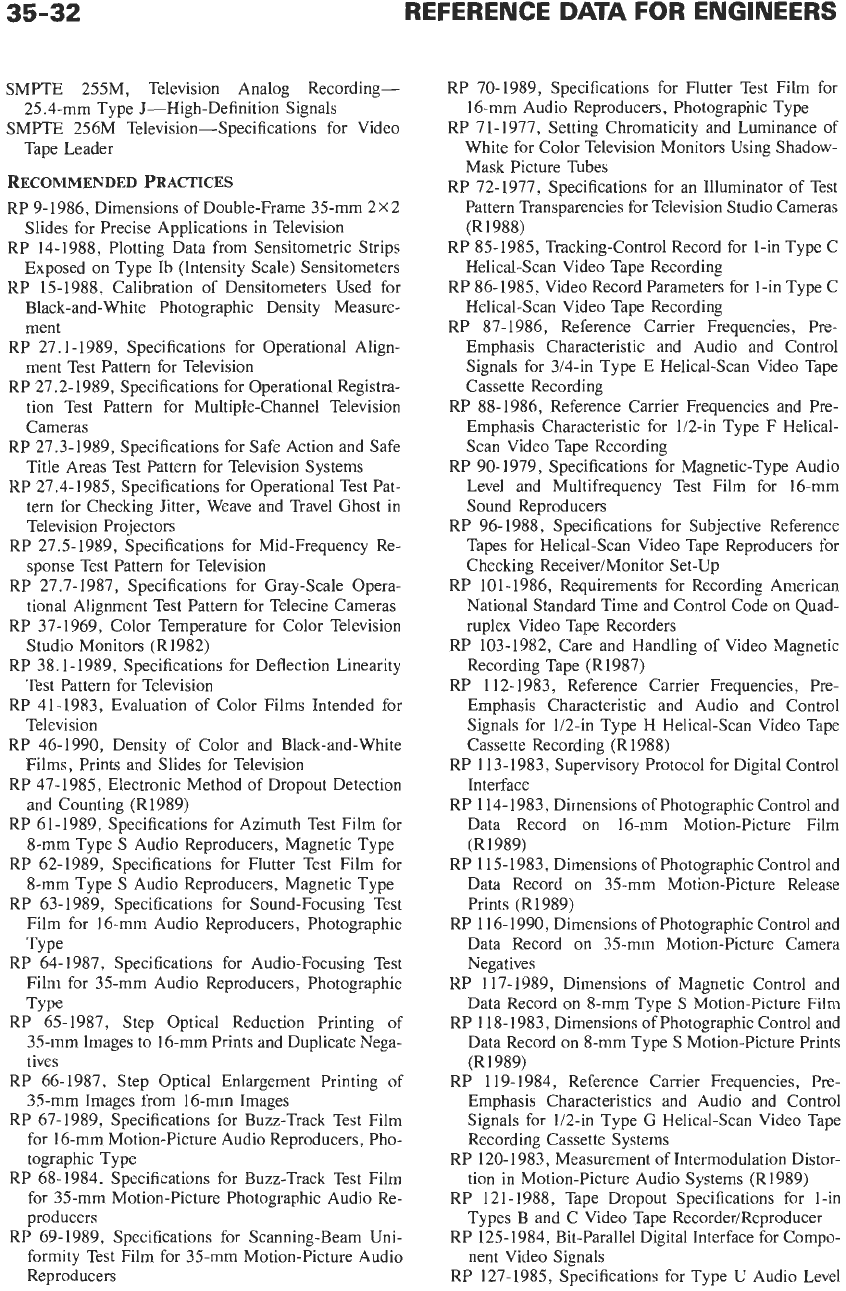
35-32
SMPTE 255M, Television Analog Recording-
SMPTE 256M Television-Specifications for Video
25.4-mm Type J-High-Definition Signals
Tape Leader
RECQMMENDED
PRACTICES
RP 9-1986, Dimensions of Double-Frame 35-mm 2x2
Slides for Precise Applications in Television
RP 14-1988, Plotting Data from Sensitometric Strips
Exposed on Type
Ib
(Intensity Scale) Sensitometers
RP 15-1988, Calibration of Densitometers Used for
Black-and-white Photographic Density Measure-
ment
RP 27.1-1989, Specifications for Operational Align-
ment Test Pattern for Television
RP 27.2- 1989, Specifications for Operational Registra-
tion Test Pattern for Multiple-Channel Television
Cameras
RP 27.3-1989, Specifications for Safe Action and Safe
Title Areas Test Pattern for Television Systems
RP 27.4-1985, Specifications for Operational Test Pat-
tern for Checking Jitter, Weave and Travel Ghost in
Television Projectors
RP 27.5-1989, Specifications for Mid-Frequency Re-
sponse Test Pattern for Television
RP 27.7-1987, Specifications for Gray-Scale Opera-
tional Alignment Test Pattern for Telecine Cameras
RP 37-1 969, Color Temperature for Color Television
Studio Monitors (R1982)
RP 38.1-1989, Specifications for Deflection Linearity
Test Pattern for Television
RP 41-1983, Evaluation of Color Films Intended for
Television
RP 46-1990, Density of Color and Black-and-white
Films, Prints and Slides for Television
RP 47-1985, Electronic Method of Dropout Detection
and Counting (R1989)
RP 61-1989, Specifications for Azimuth Test Film for
8-mm Type
S
Audio Reproducers, Magnetic Type
RP 62-1989, Specifications for Flutter Test Film for
8-mm Type
S
Audio Reproducers, Magnetic Type
RP 63-1989, Specifications for Sound-Focusing Test
Film for 16-mm Audio Reproducers, Photographic
Type
RP 64- 1987, Specifications for Audio-Focusing Test
Film for 35-mm Audio Reproducers, Photographic
Type
RP 65-1987, Step Optical Reduction Printing of
35-mm Images to 16-mm Prints and Duplicate Nega-
tives
RP 66-1987, Step Optical Enlargement Printing
of
35-mm Images from 16-mm Images
RP 67-1989, Specifications for Buzz-Track Test Film
for 16-mm Motion-Picture Audio Reproducers, Pho-
tographic Type
RP 68-1984. Specifications for Buzz-Track Test Film
for 35-mm Motion-Picture Photographic Audio Re-
producers
RP 69-1989, Specifications for Scanning-Beam Uni-
formity Test Film for 35-mm Motion-Picture Audio
Reproducers
RP 70-1989, Specifications for Flutter Test Film for
16-mm Audio Reproducers, Photographic Type
RP 71-1977, Setting Chromaticity and Luminance of
White for Color Television Monitors Using Shadow-
Mask Picture Tubes
RP 72-1977, Specifications for an Illuminator of Test
Pattern Transparencies for Television Studio Cameras
(R1988)
RP 85-1985, Tracking-Control Record for 1-in Type C
Helical-Scan Video Tape Recording
RP 86-1985, Video Record Parameters for 1-in Type
C
Helical-Scan Video Tape Recording
RP 87-1986, Reference Carrier Frequencies, Pre-
Emphasis Characteristic and Audio and Control
Signals for 3/4-in Type E Helical-Scan Video Tape
Cassette Recording
RP 88-1986, Reference Carrier Frequencies and Pre-
Emphasis Characteristic for 1/2-in Type F Helical-
Scan Video Tape Recording
RP 90- 1979, Specifications for Magnetic-Type Audio
Level and Multifrequency Test Film for 16-mm
Sound Reproducers
RP 96-1988, Specifications for Subjective Reference
Tapes for Helical-Scan Video Tape Reproducers for
Checking ReceivedMonitor Set-Up
RP 101-1986, Requirements for Recording American
National Standard Time and Control Code
on
Quad-
ruplex Video Tape Recorders
RP 103-1982, Care and Handling of Video Magnetic
Recording Tape (R1987)
RP 112-1983, Reference Carrier Frequencies, Pre-
Emphasis Characteristic and Audio and Control
Signals for li2-in Type H Helical-Scan Video Tape
Cassette Recording (R1988)
RP 113-1983. Supervisory Protocol for Digital Control
Interface
RP 114-1983, Dimensions of Photographic Control and
Data Record on 16-mm Motion-Picture Film
(R1989)
RP 115-1983, Dimensions of Photographic Control and
Data Record on 35-mm Motion-Picture Release
Prints (R1989)
RP 116-1990, Dimensions of Photographic Control and
Data Record
on
35-mm Motion-Picture Camera
Negatives
RP 117-1989, Dimensions of Magnetic Control and
Data Record on 8-mm Type
S
Motion-Picture Film
RP 118-1983, Dimensions of Photographic Control and
Data Record
on
8-mm Type
S
Motion-Picture Prints
(R1989)
RP 119-1984, Reference Carrier Frequencies, Pre-
Emphasis Characteristics and Audio and Control
Signals for 1/2-in Type G Helical-Scan Video Tape
Recording Cassette Systems
RP 120- 1983, Measurement of Intermodulation Distor-
tion in Motion-Picture Audio Systems (R1989)
RP 121-1988, Tape Dropout Specifications for 1-in
Types B and C Video Tape RecorderiReproducer
RP 125-1984, Bit-Parallel Digital Interface for Compo-
nent Video Signals
RP 127-1985, Specifications for Type
U
Audio Level
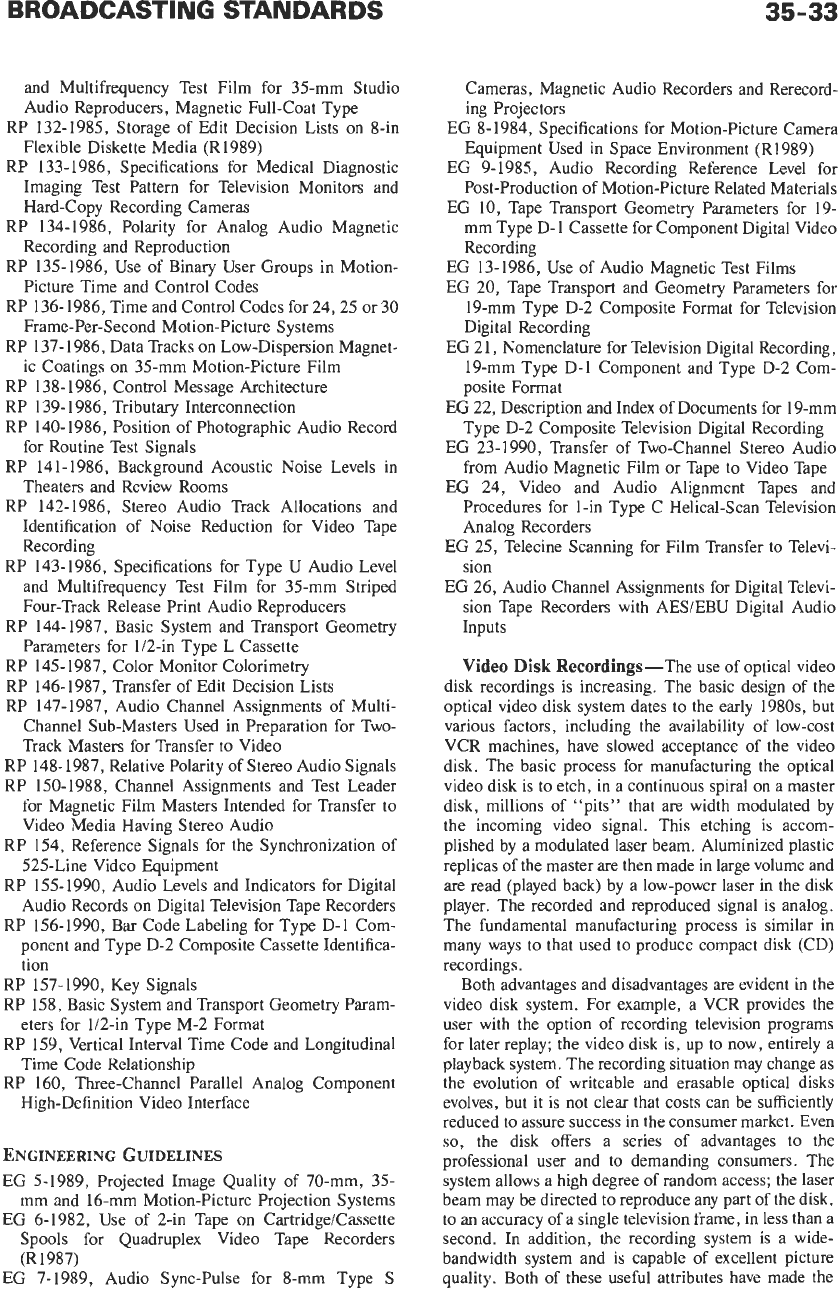
35-33
and Multifrequency Test Film for 35-mm Studio
Audio Reproducers, Magnetic Full-Coat Type
RP 132-1985, Storage of Edit Decision Lists on 8-in
Flexible Diskette Media (R1989)
RP 133-1986, Specifications for Medical Diagnostic
Imaging Test Pattern for Television Monitors and
Hard-Copy Recording Cameras
RP 134-1986, Polarity for Analog Audio Magnetic
Recording and Reproduction
RP 135-1986, Use of Binary User Groups in Motion-
Picture Time and Control Codes
RP 136-1986, Time and Control Codes for 24,25 or 30
Frame-Per-Second Motion-Picture Systems
RP 137-1986, Data Tracks on Low-Dispersion Magnet-
ic Coatings on 35-mm Motion-Picture Film
RP 138-1986, Control Message Architecture
RP 139- 1986, Tributary Interconnection
RP 140-1986, Position of Photographic Audio Record
for Routine Test Signals
RP 141-1986, Background Acoustic Noise Levels in
Theaters and Review Rooms
RP 142-1986, Stereo Audio Track Allocations and
Identification of Noise Reduction for Video Tape
Recording
RP 143-1986, Specifications for Type
U
Audio Level
and Multifrequency Test Film for 35-mm Striped
Four-Track Release Print Audio Reproducers
RP 144-1987, Basic System and Transport Geometry
Parameters for 1/2-in Type L Cassette
RP 145-1987, Color Monitor Colorimetry
RP 146-1987, Transfer of Edit Decision Lists
RP 147-1987, Audio Channel Assignments of Multi-
Channel Sub-Masters Used in Preparation for Two-
Track Masters for Transfer to Video
RP 148-1987, Relative Polarity of Stereo Audio Signals
RP 150-1988, Channel Assignments and Test Leader
for Magnetic Film Masters Intended for Transfer to
Video Media Having Stereo Audio
RP 154, Reference Signals for the Synchronization of
525-Line Video Equipment
RP 155-1990, Audio Levels and Indicators for Digital
Audio Records on Digital Television Tape Recorders
RP 156-1990, Bar Code Labeling for Type D-1 Com-
ponent and Type D-2 Composite Cassette Identifica-
tion
RP 157-1990, Key Signals
RP 158, Basic System and Transport Geometry Param-
RP 159, Vertical Interval Time Code and Longitudinal
RP 160, Three-Channel Parallel Analog Component
eters for U2-h Type M-2 Format
Time Code Relationship
High-Definition Video Interface
ENGINEERING GUIDELINES
EG
5-1989, Projected Image Quality
of
70-mm, 35-
mm and 16-mm Motion-Picture Projection Systems
EG 6-1982, Use of 2-in Tape
on
CartridgeKassette
Spools for Quadruplex Video Tape Recorders
(R1987)
EG 7-1989, Audio Sync-Pulse for 8-mm Type
S
Cameras, Magnetic Audio Recorders and Rerecord-
ing Projectors
EG 8-1984, Specifications for Motion-Picture Camera
Equipment Used in Space Environment (R1989)
EG 9-1985, Audio Recording Reference Level for
Post-Production of Motion-Picture Related Materials
EG 10, Tape Transport Geometry Parameters for 19-
mm Type D-1 Cassette for Component Digital Video
Recording
EG 13-1986, Use of Audio Magnetic Test Films
EG 20, Tape Transport and Geometry Parameters for
19-mm Type D-2 Composite Format for Television
Digital Recording
EG 21, Nomenclature for Television Digital Recording,
19-mm Type D-1 Component and Type D-2 Com-
posite Format
EG 22, Description and Index of Documents for 19-mm
Type D-2 Composite Television Digital Recording
EG 23-1990, Transfer of Two-Channel Stereo Audio
from Audio Magnetic Film or Tape to Video Tape
EG 24, Video and Audio Alignment Tapes and
Procedures for 1-in Type C Helical-Scan Television
Analog Recorders
EG 25, Telecine Scanning for Film Transfer to Televi-
sion
EG
26, Audio Channel Assignments for Digital Televi-
sion Tape Recorders with AES/EBU Digital Audio
Inputs
Video Disk Recordings-The use of optical video
disk recordings is increasing. The basic design of the
optical video disk system dates to the early 1980s, but
various factors, including the availability of low-cost
VCR machines, have slowed acceptance of the video
disk. The basic process for manufacturing the optical
video disk is to etch, in a continuous spiral on a master
disk, millions of “pits” that are width modulated by
the incoming video signal. This etching is accom-
plished by a modulated laser beam. Aluminized plastic
replicas of the master are then made in large volume and
are read (played back) by a low-power laser in the disk
player. The recorded and reproduced signal is analog.
The fundamental manufacturing process is similar in
many ways to that used to produce compact disk (CD)
recordings.
Both advantages and disadvantages are evident in the
video disk system. For example, a VCR provides the
user with the option of recording television programs
for later replay; the video disk is, up to now, entirely a
playback system. The recording situation may change as
the evolution of writeable and erasable optical disks
evolves, but it is not clear that costs can be sufficiently
reduced to assure success in the consumer market. Even
so,
the disk offers a series of advantages to the
professional user and to demanding consumers. The
system allows a high degree of random access; the laser
beam may be directed to reproduce any part of the disk,
to an accuracy of a single television frame, in less than a
second. In addition, the recording system is a wide-
bandwidth system and is capable of excellent picture
quality. Both of these useful attributes have made the
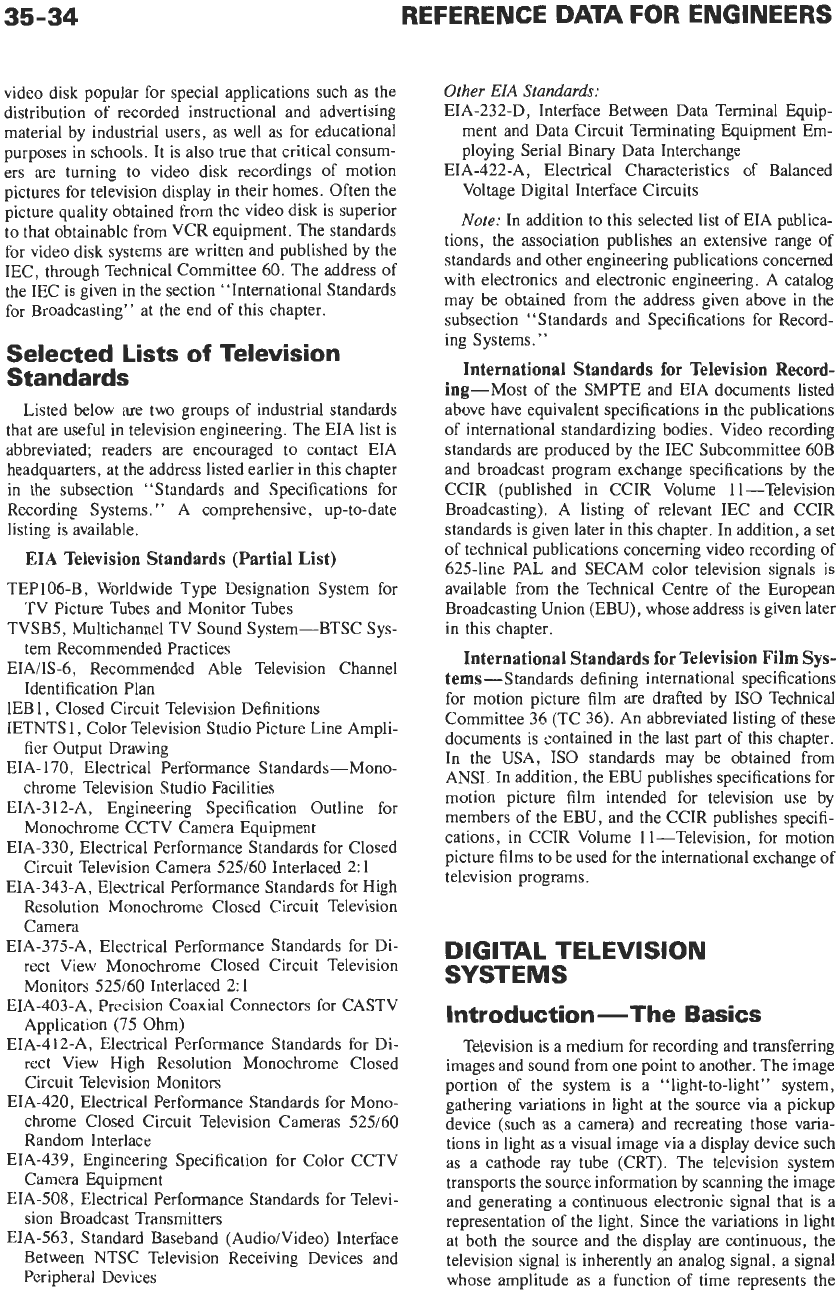
REFERENCE DATA FOR ENGINEERS
video disk popular for special applications such as the
distribution of recorded instructional and advertising
material by industrial users, as well as for educational
purposes in schools. It is also true that critical consum-
ers are turning to video disk recordings of motion
pictures for television display in their homes. Often the
picture quality obtained from the video disk is superior
to
that obtainable from VCR equipment. The standards
for video disk systems are written and published by the
IEC, through Technical Committee 60. The address of
the IEC is given in the section “International Standards
for Broadcasting” at the end of this chapter.
Selected Lists
of
Television
Standards
Listed below are two groups of industrial standards
that are useful in television engineering. The EIA list is
abbreviated; readers are encouraged to contact EIA
headquarters, at the address listed earlier in this chapter
in
the subsection “Standards and Specifications for
Recording Systems.
”
A comprehensive, up-to-date
listing is available.
EIA
Television Standards (Partial List)
TV Picture Tubes and Monitor Tubes
tem Recommended Practices
Identification Plan
TEP106-B, Worldwide Type Designation System for
TVSB5, Multichannel TV Sound System-BTSC Sys-
EIAIIS-6, Recommended Able Television Channel
IEB
1,
Closed Circuit Television Definitions
IETNTS
1,
Color Television Studio Picture Line Ampli-
fier Output Drawing
EIA-
170,
Electrical Performance Standards-Mono-
chrome Television Studio Facilities
EIA-3 12-A, Engineering Specification Outline for
Monochrome CCTV Camera Equipment
EIA-330, Electrical Performance Standards for Closed
Circuit Television Camera 525160 Interlaced 2:
1
EIA-343-A, Electrical Performance Standards for High
Resolution Monochrome Closed Circuit Television
Camera
EIA-375-A, Electrical Performance Standards for Di-
rect View Monochrome Closed Circuit Television
Monitors 525/60 Interlaced
2:
1
EIA-403-A, Precision Coaxial Connectors for CASTV
Application
(75
Ohm)
EIA412-A, Electrical Performance Standards for Di-
rect View High Resolution Monochrome Closed
Circuit Television Monitors
EIA-420, Electrical Performance Standards for Mono-
chrome Closed Circuit Television Cameras 525/60
Random Interlace
EIA-439, Engineering Specification for Color CCTV
Camera Equipment
EIA-508, Electrical Performance Standards for Televi-
sion Broadcast Transmitters
EIA-563, Standard Baseband (AudioiVideo) Interface
Between NTSC Television Receiving Devices and
Peripheral Devices
Other
EIA
Standards:
EIA-232-D, Interface Between Data Terminal Equip-
ment and Data Circuit Terminating Equipment Em-
ploying Serial Binary Data Interchange
EIA-422-A, Electrical Characteristics of Balanced
Voltage Digital Interface Circuits
Note:
In addition to this selected list of EIA publiea-
tions, the association publishes an extensive range of
standards and other engineering publications concerned
with electronics and electronic engineering. A catalog
may be obtained from the address given above
in
the
subsection ‘‘Standards and Specifications for Record-
ing Systems.”
International Standards
for
Television Record-
ing-Most of the SMPTE and EIA documents listed
above have equivalent specifications in the publications
of international standardizing bodies. Video recording
standards are produced by the IEC Subcommittee 60B
and broadcast program exchange specifications by the
CCIR (published in CCIR Volume
1
1-Television
Broadcasting). A listing of relevant IEC and CCIR
standards is given later in this chapter. In addition, a set
of technical publications concerning video recording of
625-line PAL and SECAM color television signals is
available from the Technical Centre of the European
Broadcasting Union (EBU), whose address is given later
in this chapter.
International Standards
for
Television Film
Sys-
tems-Standards defining international specifications
for motion picture film are drafted by IS0 Technical
Committee 36 (TC 36). An abbreviated listing of these
documents is contained in the last part of this chapter.
In the USA,
IS0
standards may be obtained from
ANSI. In addition, the EBU publishes specifications for
motion picture film intended for television use by
members of the EBU, and the CCIR publishes specifi-
cations, in CCIR Volume
1
I-Television, for motion
picture films to be used for the international exchange of
television programs.
DIGITAL TELEVISION
SYSTEMS
Introduction
-The
Basics
Television is a medium for recording and transferring
images and sound from one point to another. The image
portion of the system is a “light-to-light” system,
gathering variations in light at the source via a pickup
device (such as a camera) and recreating those varia-
tions in light as a visual image via a display device such
as a cathode ray tube (CRT). The television system
transports the source information by scanning the image
and generating a continuous electronic signal that is a
representation of the light. Since the variations in light
at both the source and the display are continuous, the
television signal is inherently an analog signal, a signal
whose amplitude as a function of time represents the
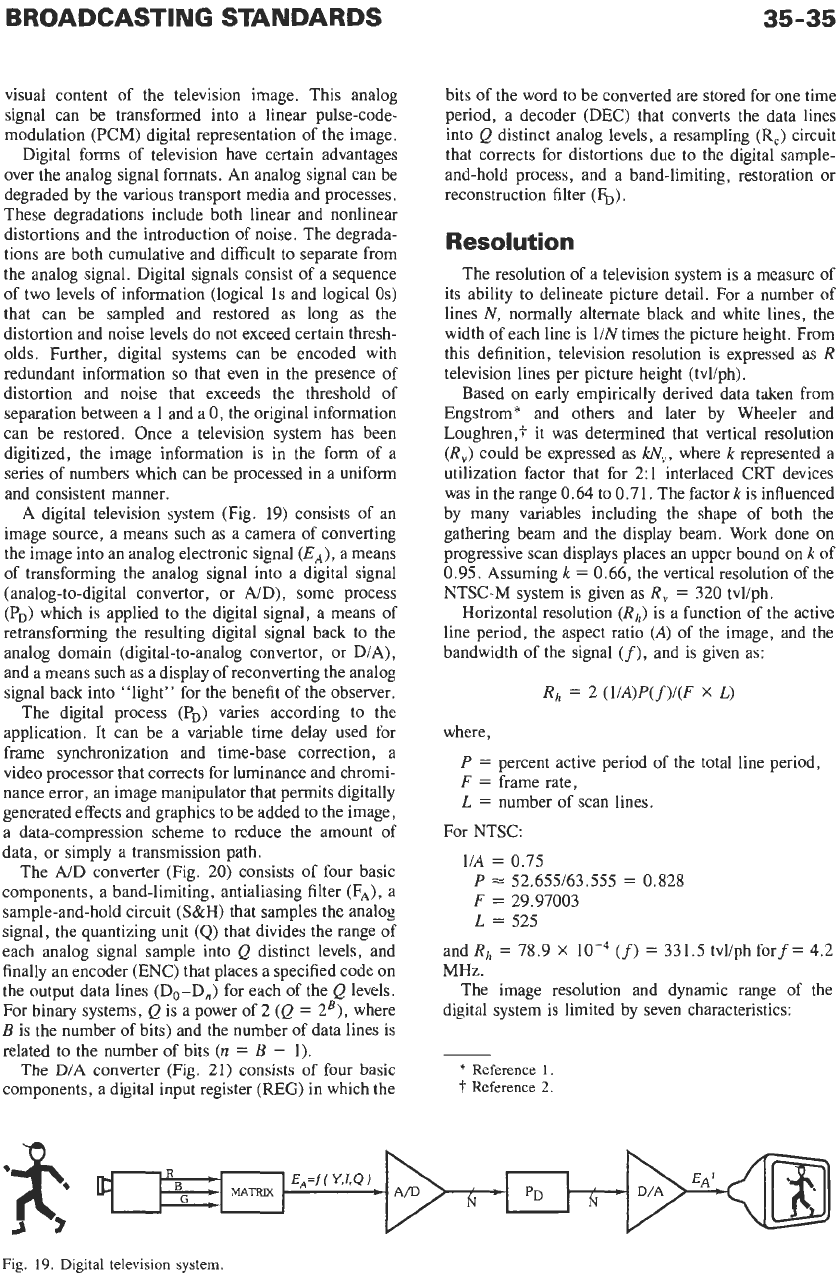
BROADCASTING STANDARD§
visual content of the television image. This analog
signal can be transformed into a linear pulse-code-
modulation (PCM) digital representation of the image.
Digital forms of television have certain advantages
over the analog signal formats. An analog signal can be
degraded by the various transport media and processes.
These degradations include both linear and nonlinear
distortions and the introduction of noise. The degrada-
tions are both cumulative and difficult to separate from
the analog signal. Digital signals consist of a sequence
of two levels of information (logical
1s
and logical
Os)
that can be sampled and restored as long as the
distortion and noise levels do not exceed certain thresh-
olds. Further, digital systems can be encoded with
redundant information
so
that even in the presence of
distortion and noise that exceeds the threshold of
separation between a
1
and a
0,
the original information
can be restored. Once a television system has been
digitized, the image information is in the form of a
series of numbers which can be processed in a uniform
and consistent manner.
A digital television system (Fig. 19) consists of an
image source, a means such as a camera of converting
the image into an analog electronic signal
(EA),
a means
of transforming the analog signal into a digital signal
(analog-to-digital convertor, or A/D), some process
(P,)
which is applied to the digital signal, a means of
retransforming the resulting digital signal back to the
analog domain (digital-to-analog convertor, or D/A),
and a means such as a display of reconverting the analog
signal back into ‘‘light” for the benefit of the observer.
The digital process
(PD)
varies according to the
application. It can be a variable time delay used for
frame synchronization and time-base correction, a
video processor that corrects for luminance and chromi-
nance error, an image manipulator that permits digitally
generated effects and graphics to be added to the image,
a data-compression scheme
to
reduce the amount of
data, or simply a transmission path.
The
A/D
converter (Fig. 20) consists of four basic
components, a band-limiting, antialiasing filter (FA), a
sample-and-hold circuit
(S&H)
that samples the analog
signal, the quantizing unit
(Q)
that divides the range of
each analog signal sample into
Q
distinct levels, and
finally an encoder (ENC) that places a specified code on
the output data lines (Do-D,) for each of the
Q
levels.
For binary systems,
Q
is a power of 2
(Q
=
29, where
B
is the number
of
bits) and the number
of
data lines is
related to the number of bits
(n
=
B
-
1).
The
D/A
converter (Fig.
21)
consists
of
four basic
components, a digital input register (REG) in which the
bits of the word
to
be converted are stored for one time
period, a decoder
(DEC)
that converts the data lines
into
Q
distinct analog levels, a resampling
(R,)
circuit
that corrects for distortions due to the digital sample-
and-hold process, and a band-limiting, restoration or
reconstruction filter
(b).
Resolution
The resolution of a television system is a measure of
its ability to delineate picture detail. For a number of
lines
N,
normally alternate black and white lines, the
width of each line is
l/N
times the picture height. From
this definition, television resolution is expressed as
R
television lines per picture height (tvl/ph).
Based on early empirically derived data taken from
Engstrom* and others and later by Wheeler and
Loughren,? it was determined that vertical resolution
(R,)
could be expressed as
W,,
where
k
represented a
utilization factor that for 2:l interlaced CRT devices
was in the range
0.64
to 0.71. The factor
k
is influenced
by many variables including the shape of both the
gathering beam and the display beam. Work done on
progressive scan displays places an upper bound on
k
of
0.95. Assuming
k
=
0.66, the vertical resolution of the
NTSC-M system is given as
R,
=
320
tvl/ph.
Horizontal resolution (Rh) is a function of the active
line period, the aspect ratio
(A)
of the image, and the
bandwidth of the signal
(f),
and
is
given as:
R,
=
2
(l/A)P(f)/(F
X
L)
where,
P
=
percent active period of the total line period,
F
=
frame rate,
L
=
number
of
scan lines.
For NTSC:
1/A
=
0.75
P
=
52.655163.555
=
0.828
F
=
29.97003
L
=
525
and
Rh
=
78.9
X
MHz.
digital system is limited by seven characteristics:
(f)
=
331.5 tvl/ph forf=
4.2
The image resolution and dynamic range of the
*
Reference
1.
t
Reference
2.
Fig.
19.
Digital television system.
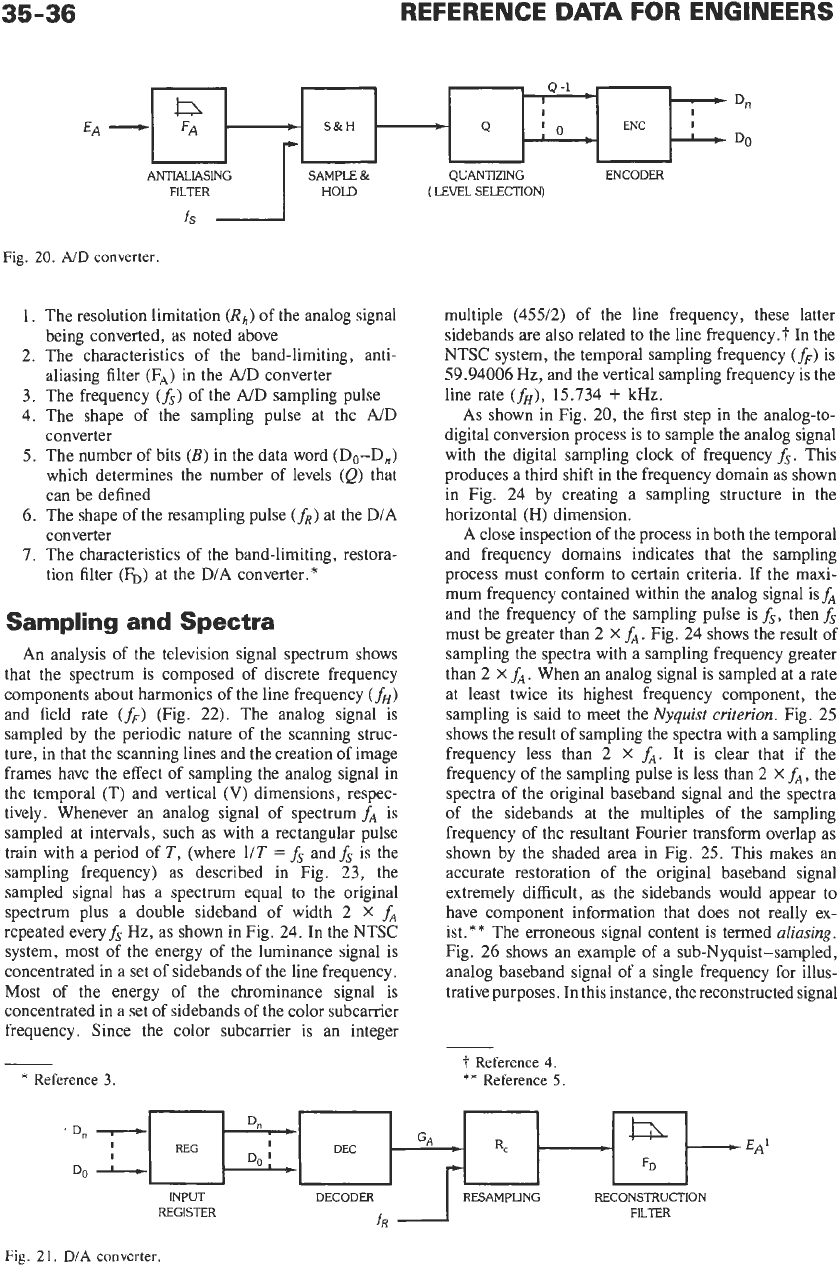
35-36
REFERENCE
DATA
FOR ENGINEERS
-
p++~l+--~Dn
DO
ANTIALIASING
r
SA:::&
QUANTIZING ENCODER
(
LEVEL
SELECTION)
F[LTER
Fig.
20.
AID
converter.
1.
The resolution limitation
(Rh)
of the analog signal
2.
The characteristics of the band-limiting, anti-
3.
The frequency
(fs)
of the
AID
sampling pulse
4.
The shape of the sampling pulse at the AID
converter
5.
The number of bits
(B)
in the data word
(Do-D,)
which determines the number of levels
(Q)
that
can be defined
6.
The shape of the resampling pulse
(fR)
at the D/A
converter
7.
The characteristics of the band-limiting, restora-
tion filter
(b)
at the
D/A
converter.*
being converted, as noted above
aliasing filter (FA) in the
AID
converter
Sampling
and
Spectra
An analysis of the television signal spectrum shows
that the spectrum is composed of discrete frequency
components about harmonics of the line frequency
(f!)
and field rate
(fF)
(Fig.
22).
The analog signal
is
sampled by the periodic nature of the scanning struc-
ture, in that the scanning lines and the creation of image
frames have the effect of sampling the analog signal in
the temporal (T) and vertical
(V)
dimensions, respec-
tively. Whenever an analog signal of spectrum
fA
is
sampled at intervals, such as with a rectangular pulse
train with a period of
T,
(where
1/T
=
fs
andfs is the
sampling frequency) as described in Fig.
23,
the
sampled signal has a spectrum equal to the original
spectrum plus a double sideband of width
2
X
fA
repeated every& Hz, as shown in Fig.
24.
In the NTSC
system, most of the energy of the luminance signal is
concentrated in a set of sidebands of the line frequency.
Most of the energy of the chrominance signal is
concentrated in a set of sidebands of the color subcarrier
frequency. Since the color subcarrier is an integer
multiple
(455/2)
of the line frequency, these latter
sidebands are also related to the line frequency.? In the
NTSC system, the temporal sampling frequency
(fF)
is
59.94006
Hz, and the vertical sampling frequency is the
line rate
(fH),
15.734
+
kHz.
As shown in Fig.
20,
the first step in the analog-to-
digital conversion process is to sample the analog signal
with the digital sampling clock of frequency
fs.
This
produces a third shift in the frequency domain as shown
in Fig.
24
by creating a sampling structure in the
horizontal (H) dimension.
A close inspection of the process in both the temporal
and frequency domains indicates that the sampling
process must conform
to
certain criteria. If the maxi-
mum frequency contained within the analog signal ish
and the frequency of the sampling pulse is
fs,
then
fs
must be greater than
2
X
fA.
Fig.
24
shows the result of
sampling the spectra with a sampling frequency greater
than
2
x
fA.
When an analog signal is sampled at a rate
at least twice its highest frequency component, the
sampling is said to meet the
Nyquist
criterion.
Fig.
25
shows the result of sampling the spectra with a sampling
frequency less than
2
X
fA.
It is clear that if the
frequency of the sampling pulse is less than
2
X
fA,
the
spectra of the original baseband signal and the spectra
of the sidebands at the multiples of the sampling
frequency of the resultant Fourier transform overlap as
shown by the shaded area in Fig.
25.
This makes an
accurate restoration of the original baseband signal
extremely difficult, as the sidebands would appear to
have component information that does not really ex-
ist.
*
*
The erroneous signal content is termed
aliasing.
Fig.
26
shows an example of a sub-Nyquist-sampled,
analog baseband signal
of
a single frequency for illus-
trative purposes. In this instance, the reconstructed signal
*
Reference
3.
7'
Reference
4.
**
Reference
5.
EA'
DECODER RECONSTRUCTION
INPUT
REGISTER FILTER
Fig.
21.
DIA
converter.
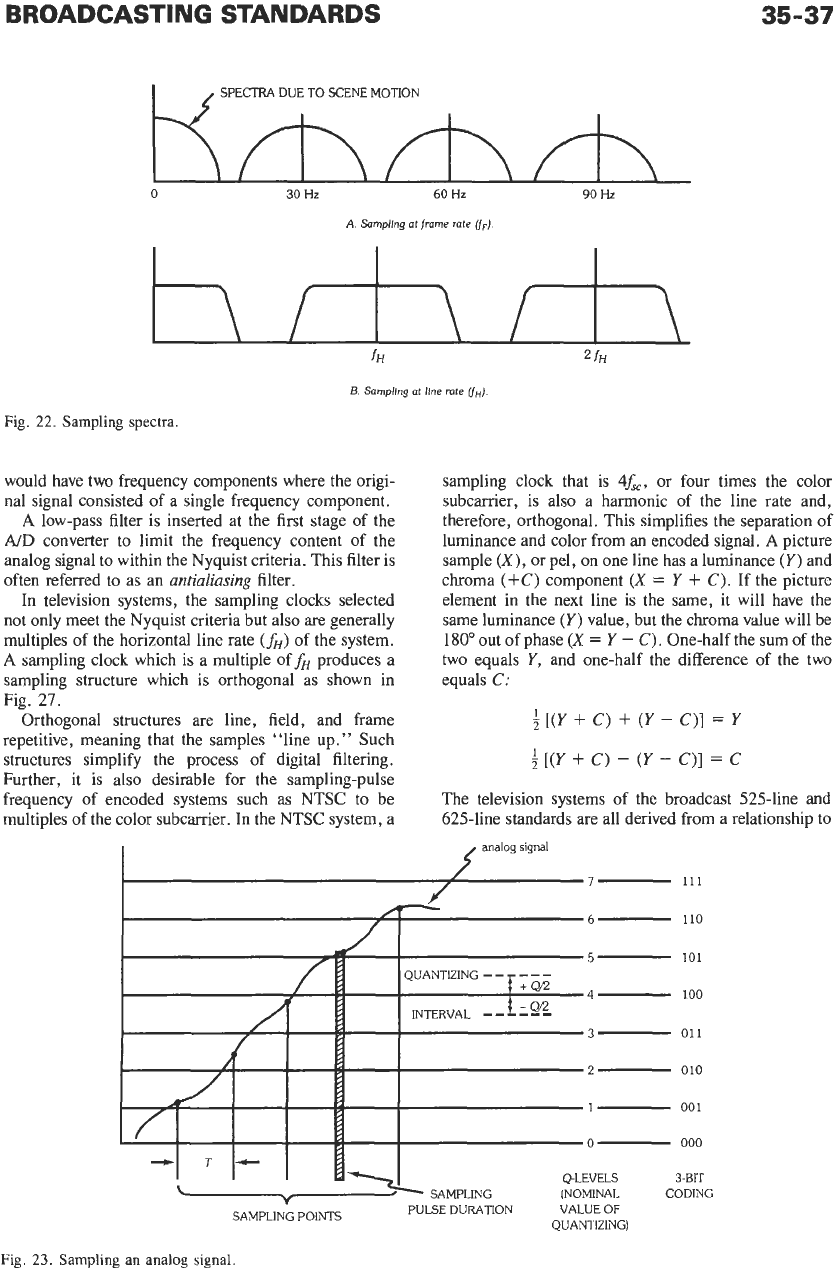
BROADCASTING STANDARDS
35-37
I
1
SPECTRA
DUE
TO SCENE MOTION
0
30
Hz
60
Hz
90
Hz
A.
Sampling
at
frome
rote
(fF)
fH
fH
B.
Sompllng
at
line
rate
(fHJ.
Fig.
22.
Sampling spectra.
would have two frequency components where the origi-
nal signal consisted of a single frequency component.
A
low-pass filter is inserted at the first stage of the
A/D
converter to limit the frequency content
of
the
analog signal to within the Nyquist criteria. This filter is
often referred to as an
antialiasing
filter.
In television systems, the sampling clocks selected
not only meet the Nyquist criteria but also are generally
multiples of the horizontal line rate
(fH)
of the system.
A
sampling clock which is a multiple of
fH
produces a
sampling structure which is orthogonal as shown in
Fig.
21.
Orthogonal structures are line, field, and frame
repetitive, meaning that the samples “line up.” Such
structures simplify the process of digital filtering.
Further, it is also desirable for the sampling-pulse
frequency of encoded systems such as NTSC to be
multiples of the color subcarrier. In the NTSC system, a
sampling clock that is
4f,.
or four times the color
subcarrier, is also a harmonic of the line rate and,
therefore, orthogonal. This simplifies the separation
of
luminance and color from an encoded signal.
A
picture
sample
(X),
or pel, on one line has a luminance
(Y)
and
chroma
(+C)
component
(X
=
Y
+
C).
If
the picture
element in the next line
is
the same, it will have the
same luminance
(Y)
value, but the chroma value will be
180”
out of phase
(X
=
Y
-
C)
,
One-half the sum of the
two equals
Y,
and one-half the difference of the two
equals
C:
;
[(Y
+
C)
+
(Y
-
C)]
=
Y
;
[(Y
+
C)
-
(Y
-
C)]
=
c
The television systems of the broadcast 525-line and
625-line standards
are
all derived from a relationship to
analog signal
___
6
110
5
101
4
100
3
011
2
010
1
001
0
000
QLEVELS
3-BIT
(NOMINAL CODING
PULSE DURATION VALUE
OF
QUANTIZING)
SAMPLING
POINTS
Fig.
23.
Sampling
an
analog signal.
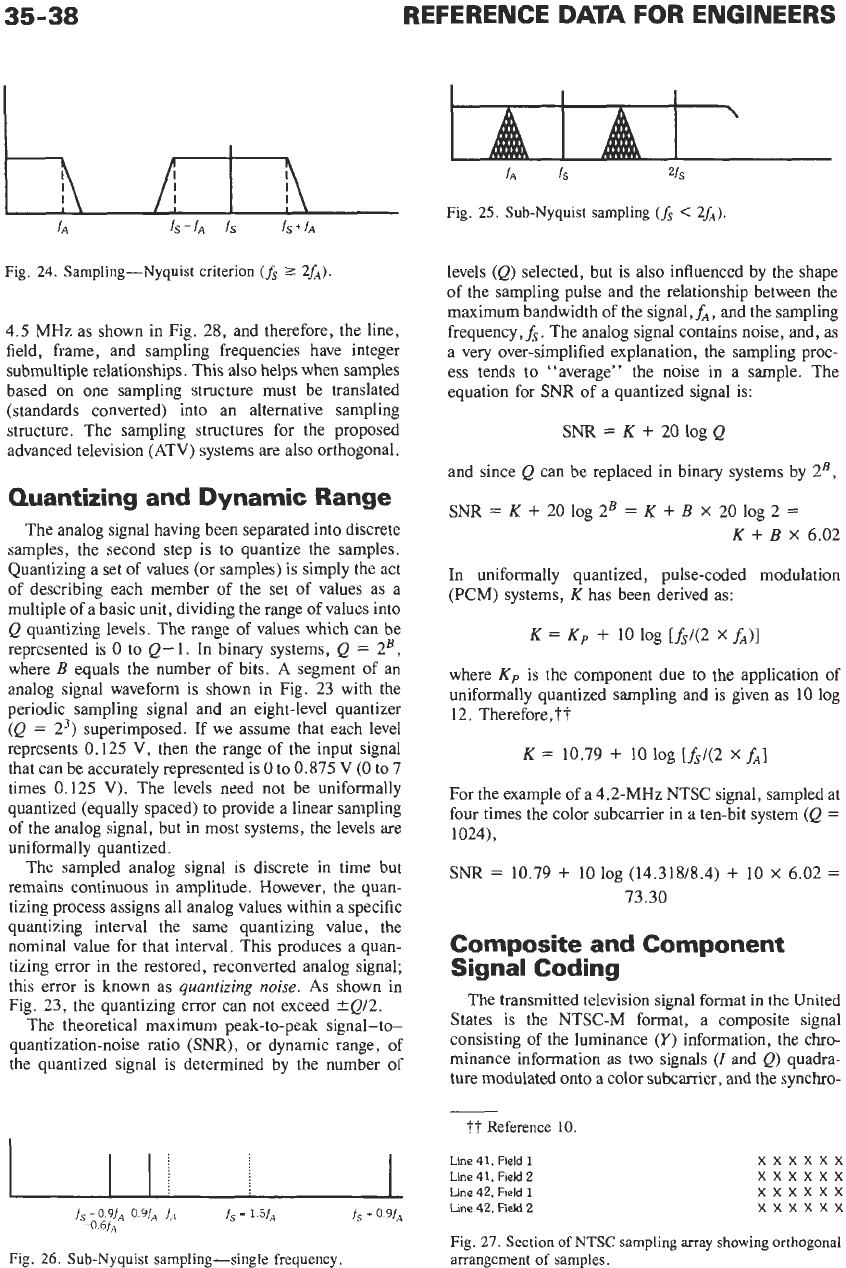
35-38
REFERENCE
DATA
FOR ENGINEERS
Fig,
25.
Sub-Nyquist sampling
(fs
<
2fa).
Fig.
24.
Sampling-Nyquist criterion
(fs
2
2fA).
4.5 MHz as shown in Fig. 28, and therefore, the line,
field, frame, and sampling frequencies have integer
submultiple relationships. This also helps when samples
based on one sampling structure must be translated
(standards converted) into an alternative sampling
structure. The sampling structures for the proposed
advanced television (ATV) systems are also orthogonal.
Quantizing
and
Dynamic Range
The analog signal having been separated into discrete
samples, the second step is to quantize the samples.
Quantizing a set of values (or samples)
is
simply the act
of describing each member of the set of values as a
multiple of a basic unit, dividing the range of values into
Q
quantizing levels. The range of values which can be
represented is
0
to Q- 1. In binary systems,
Q
=
2’,
where
B
equals the number of bits. A segment of an
analog signal waveform
is
shown in Fig. 23 with the
periodic sampling signal and an eight-level quantizer
(Q
=
Z3) superimposed. If we assume that each level
represents 0.125 V, then the range of the input signal
that can be accurately represented is
0
to 0.875
V
(0
to
7
times 0.125 V). The levels need not be uniformally
quantized (equally spaced) to provide a linear sampling
of the analog signal, but in most systems, the levels are
uniformally quantized.
The sampled analog signal is discrete in time but
remains continuous in amplitude. However, the quan-
tizing process assigns all analog values within a specific
quantizing interval the same quantizing value, the
nominal value for that interval. This produces a quan-
tizing error in the restored, reconverted analog signal;
this error
is
known as
quantizing
noise.
As shown in
Fig. 23, the quantizing error can not exceed +Q/2.
The theoretical maximum peak-to-peak signal-to-
quantization-noise ratio (SNR), or dynamic range, of
the quantized signal is determined by the number
of
levels (Q) selected, but is also influenced by the shape
of the sampling pulse and the relationship between the
maximum bandwidth of the signal,&, and the sampling
frequency,&. The analog signal contains noise, and, as
a very over-simplified explanation, the sampling proc-
ess tends to “average” the noise in a sample. The
equation for SNR of a quantized signal is:
SNR
=
K
+
20 log
Q
and since
Q
can be replaced in binary systems by 2’,
SNR
=
K
+
20
log 2’
=
K
+
B
X
20
log
2
=
K
+
B
X
6.02
In uniformally quantized, pulse-coded modulation
(PCM) systems,
K
has been derived as:
K
=
Kp
+
10 log [&1(2
X
&)I
where
Kp
is the component due to the application of
uniformally quantized sampling and is given as
10
log
12. Therefore,??
K
=
10.79
+
10
log [fs/(2
X
fA]
For the example of a 4.2-MHz NTSC signal, sampled at
four times the color subcarrier in a ten-bit system
(Q
=
1024),
SNR
=
10.79
+
10 log (14.318/8.4)
+
10
X
6.02
=
73.30
Composite
and
Component
Signal Coding
The transmitted television signal format in the United
States is the NTSC-M format, a composite signal
consisting
of
the luminance
(Y)
information, the chro-
minance information as two signals
(I
and Q) quadra-
ture modulated onto a color subcarrier, and the synchro-
Fig.
26.
Sub-Nyquist
sampling-single frequency.
ti
Reference
10.
Line
41, Field
1
Line
41, Field 2
Line
42, Field
1
Line
42,
Field
2
xxxxxx
xxxxxx
xxxxxx
xxxxxx
Fig.
27.
Section
of
NTSC
sampling
array
showing orthogonal
arrangement
of
samples.
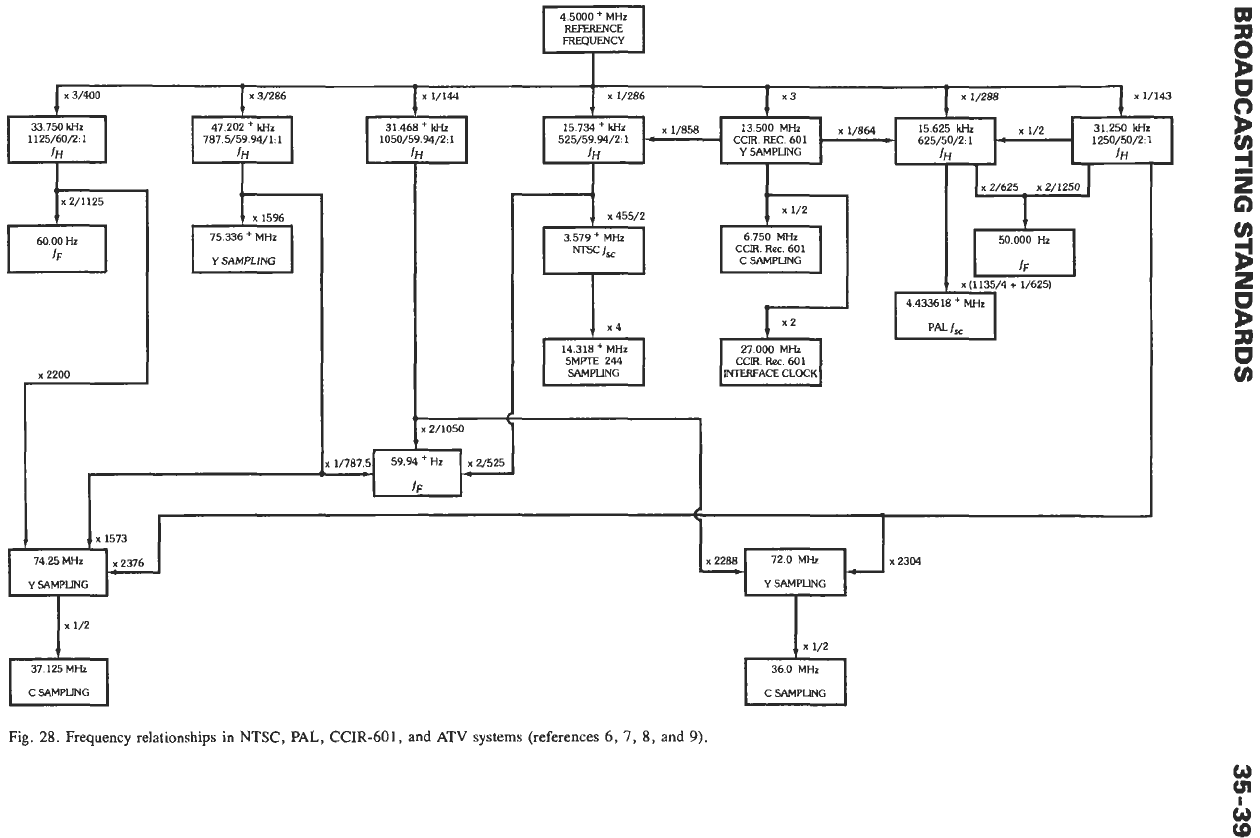
33.750
kHz
1125/60/2:1
x
3/286
47.202
+
WHZ
787.5/59.94/1:
1
31.468
+
kH2
1050/59.94/2:1
x
2/1050
I
I
1
x
455/2
14.318
+
MHz
CUR.
Ree.
601
F-
I
27.000
MHz
CCR.
Re=.
601
I
INERFACE
CLOCK
.
1
x
1573
74.25
MHZ
x
2376
x
2304
-
-
Y
SAMPIING
Y
SAMPLING
x
1/2
T
37.125
MHz
360
MHz
C
SAMPLING
C
SAMPLING
Fig. 28. Frequency relationships in
NTSC,
PAL,
CCIR-601,
and
ATV
systems (references
6,
7,
8,
and
9).
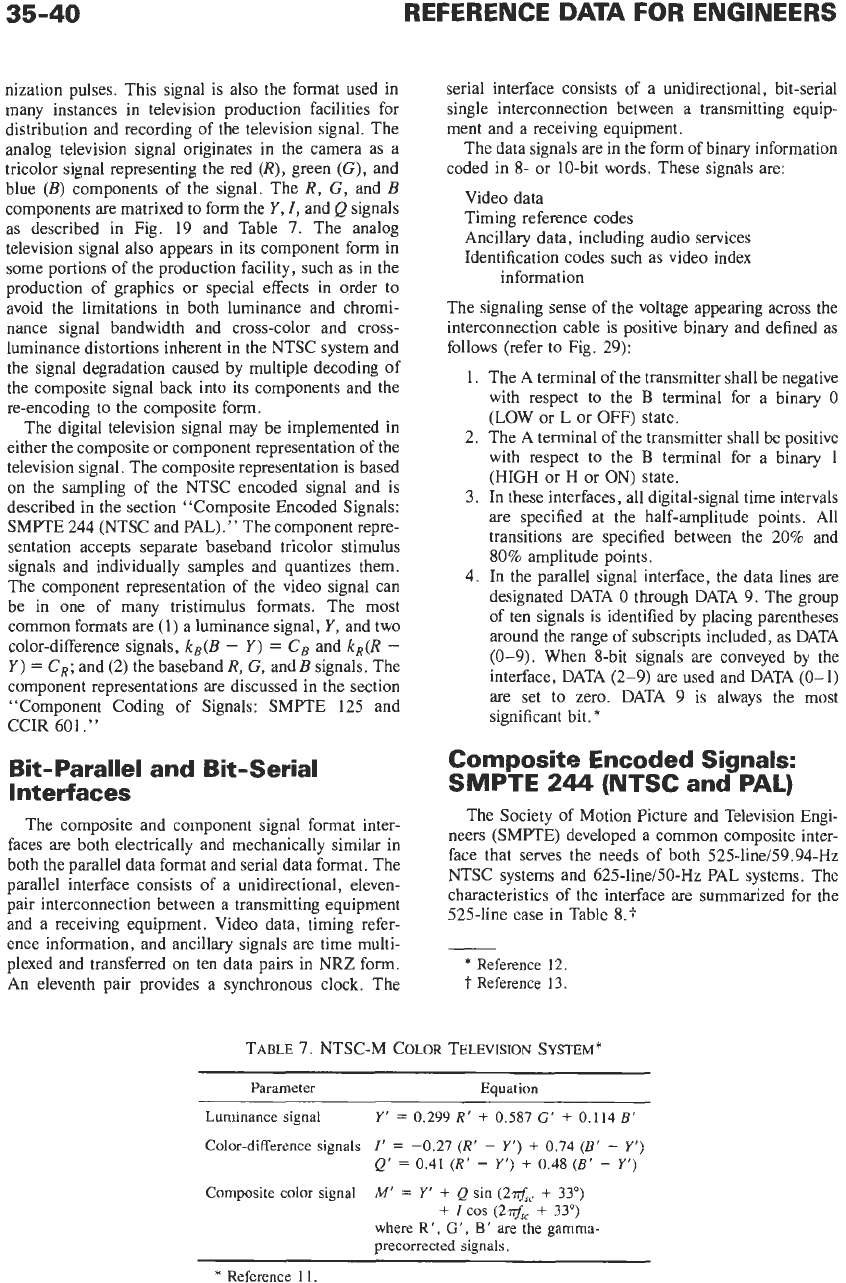
35-40
REFERENCE DATA FOR ENGINEERS
nization pulses. This signal is also the format used in
many instances in television production facilities for
distribution and recording of the television signal. The
analog television signal originates in the camera
as
a
tricolor signal representing the red
(R),
green (G), and
blue
(B)
components of the signal. The R,
G,
and
B
components are matrixed to form the
Y,
I,
and Q signals
as described in Fig.
19 and Table
7.
The analog
television signal also appears in its component form in
some portions of the production facility, such as in the
production of graphics or special effects in order to
avoid the limitations in both luminance and chromi-
nance signal bandwidth and cross-color and cross-
luminance distortions inherent in the NTSC system and
the signal degradation caused by multiple decoding of
the composite signal back into its components and the
re-encoding to the composite form.
The digital television signal may be implemented in
either the composite or component representation
of
the
television signal. The composite representation is based
on the sampling of the NTSC encoded signal and is
described in the section “Composite Encoded Signals:
SMPTE
244
(NTSC and PAL).” The component repre-
sentation accepts separate baseband tricolor stimulus
signals and individually samples and quantizes them.
The component representation of the video signal can
be in one of many tristimulus formats. The most
common formats are
(1)
a luminance signal,
Y,
and two
color-difference signals,
ks(B
-
Y)
=
CB
and
kR(R
-
Y)
=
CR;
and (2) the baseband
R,
G, and
B
signals. The
component representations are discussed in the section
“Component Coding of Signals: SMPTE 125 and
CCIR 601
.”
Bit-Parallel and Bit-Serial
Interfaces
The composite and component signal format inter-
faces are both electrically and mechanically similar in
both the parallel data format and serial data format. The
parallel interface consists of a unidirectional, eleven-
pair interconnection between a transmitting equipment
and a receiving equipment. Video data, timing refer-
ence information, and ancillary signals are time multi-
plexed and transferred on ten data pairs in NRZ form.
An eleventh pair provides
a
synchronous clock. The
serial interface consists of a unidirectional, bit-serial
single interconnection between a transmitting equip-
ment and a receiving equipment.
The data signals are in the form of binary information
coded in 8- or 10-bit words. These signals are:
Video data
Timing reference codes
Ancillary data, including audio services
Identification codes such as video index
information
The signaling sense of the voltage appearing across the
interconnection cable is positive binary and defined as
follows (refer
to
Fig. 29):
1.
The A terminal of the transmitter shall be negative
with respect to the
B
terminal for a binary
0
(LOW or L or OFF) state.
2. The A terminal of the transmitter shall be positive
with respect to the
B
terminal for a binary
1
(HIGH or H or ON) state.
3.
In these interfaces, all digital-signal time intervals
are specified at the half-amplitude points. All
transitions are specified between the
20%
and
80% amplitude points.
4.
In the parallel signal interface, the data lines are
designated DATA
0
through DATA 9. The group
of
ten signals is identified by placing parentheses
around the range of subscripts included, as DATA
(0-9). When 8-bit signals are conveyed by the
interface, DATA (2-9) are used and DATA (0-1)
are set
to
zero. DATA 9 is always the most
significant bit.
*
Composite Encoded Signals:
SMPTE
244
(NTSC
and
PAL)
The Society of Motion Picture and Television Engi-
neers (SMPTE) developed a common composite inter-
face that serves the needs of both 525-line/59.94-Hz
NTSC systems and 625-line/50-Hz PAL systems. The
characteristics of the interface are summarized for the
525-line case in Table 8.:
-
*
Reference
12.
T
Reference 13.
TABLE
7.
NTSC-M COLOR TELEVISION
SYSTEM*
Parameter Equation
Luminance
signal
Y’
=
0.299
R‘
+
0.587
G‘
+
0.114
B‘
Color-difference signals
I’
=
-0.27
(R’
-
Y’)
+
0.74
(B’
-
Y’)
Q‘
=
0.41
(R’
-
Y’)
+
0.48
(B’
-
Y’)
M’
=
Y‘
+
Q
sin
(2?rf,,
+
33”)
where
R’,
G’,
B’
are
the
gamma-
precorrected signals.
Composite
color
signal
+
I
cos
(2?rf,,
+
33”)
*
Reference 11.
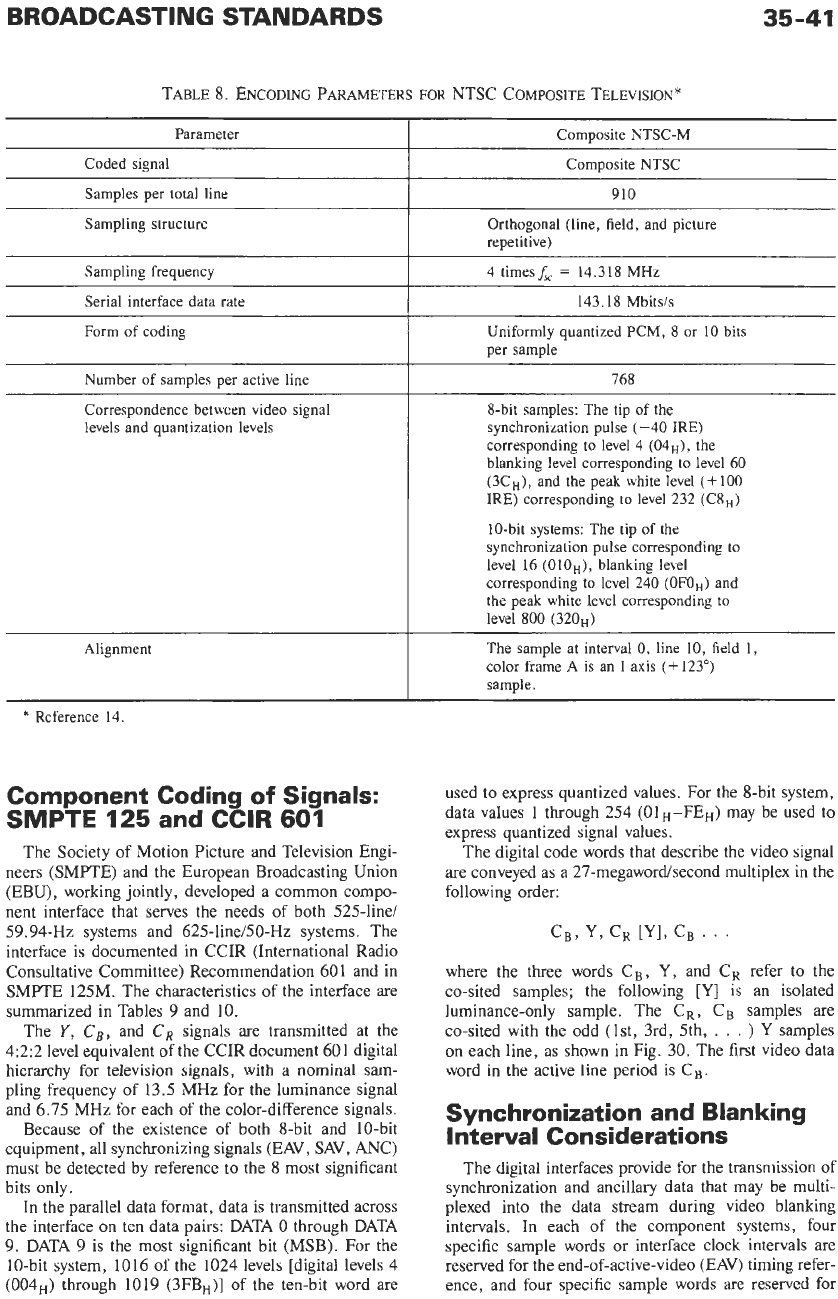
BROADCASTING STANDARDS
TABLE
8.
ENCODING PARAMETERS
FOR
NTSC COMPOSlTE TELEVISION"
35-41
Parameter
Coded signal
Samples per total line
Sampling structure
Sampling frequency
Serial interface data rate
Form of coding
Number
of
samples per active line
Correspondence between video
signal
levels
and
quantization
levels
Alignment
*
Reference 14.
Component Coding
of
Signals:
SMPTE
125 and CCIR
601
The Society of Motion Picture and Television Engi-
neers (SMPTE) and the European Broadcasting Union
(EBU), working jointly, developed a common compo-
nent interface that serves the needs of both 525-line/
59.94-Hz systems and 625-line/50-Hz systems. The
interface is documented in CCIR (International Radio
Consultative Committee) Recommendation
60
1
and in
SMPTE 125M. The characteristics of the interface are
summarized in Tables 9 and
10.
The
Y,
CB,
and
CR
signals are transmitted at the
4:2:2 level equivalent of the CCIR document
601
digital
hierarchy for television signals, with a nominal sam-
pling frequency of 13.5 MHz for the luminance signal
and 6.75 MHz for each of the color-difference signals.
Because of the existence of both 8-bit and 10-bit
equipment, all synchronizing signals (EAV, SAV, ANC)
must be detected by reference to the
8
most significant
bits only.
In
the parallel data format, data is transmitted across
the interface on ten data pairs: DATA
0
through DATA
9. DATA 9 is the most significant bit (MSB). For the
10-bit system,
1016
of the 1024 levels [digital levels 4
(004,) through 1019 (3FBH)]
of
the ten-bit word are
Composite NTSC-M
Composite NTSC
910
Orthogonal (line, field,
and
picture
repetitive)
4 timesf,
=
14.318 MHz
143.18 Mbitsls
Uniformly quantized PCM, 8
or
10
bits
per sample
768
8-bit samples: The
tip
of
the
synchronization pulse (-40
IRE)
corresponding to level
4
(04H), the
blanking level corresponding to level
60
(3CH),
and
the
peak
white level (+lo0
IRE)
corresponding to level 232 (C8,)
10-bit systems: The tip
of
the
synchronization pulse corresponding
to
level
16
(OIOH), blanking level
corresponding to level 240
(OFOH)
and
the peak white level corresponding
to
level
800
(320")
The sample
at
interval
0,
line 10,
field
1,
color frame
A
is
an
I
axis
(+
123")
sample.
used to express quantized values. For the 8-bit system,
data values 1 through 254 (OIH-FE,) may be used to
express quantized signal values.
The digital code words that describe the video signal
are conveyed as a 27-megaword/second multiplex in the
following order:
CB?
y,
cR
[yl,
CB
. .
.
where the three words CB,
Y,
and CR refer to the
co-sited samples; the following
[Y]
is an isolated
luminance-only sample. The CR,
CB
samples are
co-sited with the odd (Ist, 3rd, 5th,
. .
.
)
Y
samples
on
each line, as shown
in
Fig. 30. The first video data
word in the active line period is
CB
.
Synchronization and Blanking
Interval Considerations
The digital interfaces provide for the transmission of
synchronization and ancillary data that may be multi-
plexed into the data stream during video blanking
intervals.
In
each of the component systems, four
specific sample words or interface clock intervals are
reserved for the end-of-active-video
(EAV)
timing refer-
ence, and four specific sample words are reserved for
